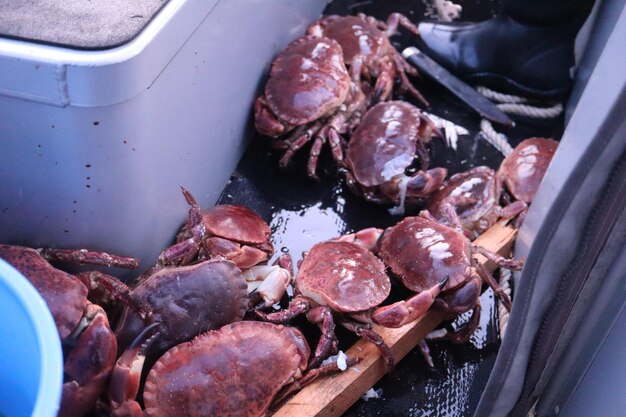How Long Can You Keep Crabs in the Refrigerator: A Guide to Shelf Life and Storage
Imagine this: You've just prepared a delightful seafood feast, and amidst the delectable spread lay succulent crabs. However, after the meal, you find yourself with leftover crabs. So, the question arises: How long are these crabs good for if stored in the refrigerator? Let's delve into this topic and explore useful storage tips to maximize their freshness and flavor.
Understanding Crab Shelf Life
Crabs are a highly perishable seafood item, and their freshness can significantly impact the flavor and safety of your meal. Proper storage is crucial to retaining their taste and nutritional value. Generally, fresh crabs, whether cooked or uncooked, should be consumed within a short time frame to ensure they are safe and delicious.
Fresh vs. Cooked Crabs
Fresh (Raw) Crabs: If you've bought live crabs or raw crab meat, consumption should ideally happen within 24 to 48 hours. Raw crabs can harbor bacteria quickly, so refrigeration is only a short-term solution.
Cooked Crabs: Cooked crabs, on the other hand, can last a bit longer. On average, they remain good for about 3 to 5 days in the refrigerator. Proper storage practices are paramount to maintaining this shelf life.
Essential Storage Tips for Keeping Crabs Fresh
Refrigeration Best Practices
When it comes to refrigerating crabs, keeping them in optimal conditions helps prolong their freshness. Here are some tips for both raw and cooked crabs:
Cool Down Quickly: If you've cooked the crabs, allow them to cool to room temperature before refrigerating. This prevents condensation, which can lead to bacterial growth.
Airtight Containers: Place the crabs in airtight containers to minimize moisture loss and prevent them from absorbing other odors in the fridge. Alternatively, tightly wrapping them in plastic or using vacuum-sealed bags can also do the trick.
Labeling and Dating: Always label the storage container with the date they were cooked or purchased. This ensures you keep track of their freshness and avoid consuming spoiled seafood.
Temperature Settings: Ensure your refrigerator is set to the correct temperature, ideally at 35°F to 38°F. Keeping crabs at a constant, cool environment slows bacterial growth.
Freezing for Extended Shelf Life
If you’d like to keep crabs longer than a few days, freezing is a viable option. Here are steps to properly freeze crabs:
For Raw Crabs: It's best to cook crabs before freezing, as cooking kills bacteria and enzymes that can degrade quality over time.
For Cooked Crabs: Once cooled, prepare the crabs for freezing by wrapping them in a layer of plastic wrap followed by aluminum foil, or place them in freezer-safe bags. Aim for a double layer to protect against freezer burn.
Thawing Tips: When ready to eat, thaw crabs in the refrigerator overnight or use cold water for a quicker method. Avoid thawing at room temperature to minimize the risk of bacterial growth.
Assessing Crab Freshness: Signs of Spoilage
Knowing how to identify signs of spoilage is crucial. Here’s what to look for in crabs that have been stored:
Off-Putting Odor: A strong, fishy smell is a clear indicator of spoilage. Fresh crabs have a light ocean aroma; anything stronger should be a red flag.
Discoloration: Look for any unusual color changes in the meat or shell. A bluish or greyish tint in the flesh is not typical of fresh crabs.
Texture Changes: If the crab meat feels mushy or slimy, it’s a sign of spoilage.
Safe and Tasty Ways to Use Leftover Crabs
When you have leftover crabs that are still good, here are some ideas to incorporate them into your meals:
Crab Cakes: Mix crab meat with breadcrumbs, herbs, and spices, then pan-fry for delicious crab cakes.
Seafood Salad: Add chilled, cooked crab to a bed of lettuce with avocado, tomatoes, and a light vinaigrette.
Crab Soup or Chowder: Enhance a homemade soup or chowder with crab meat for added flavor and protein.
Missteps to Avoid When Storing Crabs
Handling and storing crabs incorrectly can lead to premature spoilage. Here are common missteps to avoid:
Room Temperature Storage: Never leave crabs at room temperature for extended periods, as this accelerates bacterial growth.
Cross Contamination: When storing, keep crabs separate from raw meats to avoid cross-contamination, which can lead to foodborne illness.
Ignoring Storage Instructions: Always follow the storage guidelines that come with store-bought crab products, as they are tailored to maximize freshness and safety.
🦀 Quick Summary: Crab Storage Tips 🦀
- Fresh Crabs: Consume within 24 to 48 hours.
- Cooked Crabs: Refrigerate and consume within 3 to 5 days.
- Storage Containers: Use airtight containers to prevent odor transfer and moisture loss.
- Freezing: Choose freezing for longer shelf life; avoid freezer burn with proper wrapping.
- Spoilage Signs: Watch for off-putting odors, discoloration, and texture changes.
Proper storage and handling of crabs not only ensure their safety but also preserve their rich, delicious taste. By following these guidelines, you can enjoy your seafood dishes at their finest while minimizing waste. Whether you whip up a batch of crab cakes or a seafood stew, remember that fresh and well-stored crabs can elevate any meal to a gourmet experience.
